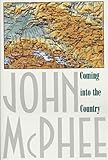John McPhee somewhat famously teaches writing to undergrads at Princeton. So, what’s on his syllabus?
 McPhee has been one of my favorite writers ever since I absently picked up a copy of Coming into the Country while working the cash register at Book Soup in L.A. and blazed through it in a day or two. I was hooked. From then on, I scanned the table of contents in each new New Yorker for the name McPhee. Meanwhile, McPhee’s books, many in number and varied in subject, were ideal targets for used bookstore visits. I found Table of Contents in a pile of books on the sidewalk. I spotted The McPhee Reader on my father in law’s bookshelves. I picked up a remaindered copy of Annals of the Former World, wanting the largest possible dose of McPhee.
McPhee has been one of my favorite writers ever since I absently picked up a copy of Coming into the Country while working the cash register at Book Soup in L.A. and blazed through it in a day or two. I was hooked. From then on, I scanned the table of contents in each new New Yorker for the name McPhee. Meanwhile, McPhee’s books, many in number and varied in subject, were ideal targets for used bookstore visits. I found Table of Contents in a pile of books on the sidewalk. I spotted The McPhee Reader on my father in law’s bookshelves. I picked up a remaindered copy of Annals of the Former World, wanting the largest possible dose of McPhee.
I also soon discovered that he teaches a class to undergrads at Princeton. It’s in some places referred to as “Creative Nonfiction” and in others as “The Literature of Fact.” A 2007 article in the Princeton Weekly Bulletin offers the most detail, including an example of his rather unique technique for visualizing story structure:
“I’m obsessed with the structure of pieces of writing,” explained McPhee, the Pulitzer Prize-winning author and Princeton’s Ferris Professor of Journalism, who has taught his legendary class on writing at the University for more than 30 years.
For his students, McPhee sketches primitive diagrams – a horizontal line with loops above and below it to represent the tangents along the storyline, a circle with lines shooting out of it that denote narrative pathways – to illustrate how a piece of writing is assembled. The “doodles,” as he calls them, are projected on a screen in front of the class.
Students get to hear from some impressive visitors, and get plenty of face time with McPhee himself:
McPhee requires the same of the 16 students – all sophomores – in his “Creative Nonfiction” course, in which students discuss and practice the craft of writing through reading, listening to guest lecturers like New Yorker writers Ian Frazier and Mark Singer and, most critically, meeting one-on-one with McPhee for private conferences about their work. After McPhee marks up the students’ papers, he sits down with each student and goes over the writing line by line.
Another interesting tidbit:
Other former students include David Remnick, now The New Yorker’s editor (“I’m proud of the fact that he’s turned down work of mine,” McPhee said)
It’s a fascinating little profile of McPhee, but it left one big question unanswered. What’s on John McPhee’s syllabus? Who do his students read? It turns out to be hard info to find, and some time spent with Google turned up what might be the reason why; to quote McPhee, himself, “There’s no syllabus.”
This comes from a 2005 piece called “Courses in science writing as literature” in the academic journal Public Understanding of Science, which includes a bit on McPhee. The piece isn’t freely available online, but with Google I was able to piece together the relevant section:
The most famous nonfiction literature course is probably The Literature of Fact, taught since 1975 at Princeton University by Pulitzer Prize-winning author John McPhee. It is widely cited as a science-writing-as-literature course, but McPhee disavows this label. “My course is not devoted to science writing . . . It’s a plain writing course with no thematic base . . . There’s no syllabus. Reading varies each year. Mostly, I give them books of mine to read. (such as The Deltoid Pumpkin Seed and Looking for a Ship)”
I had a flash of disappointment upon reading this before realizing that, with about eight McPhee books under my belt, I’m already well into the McPhee syllabus. Reading McPhee’s books is an education in Creative Nonfiction unto itself.
Bonus News: We’ve recently heard that McPhee has a new book coming out in March 2010 called Silk Parachute. McPhee wrote a 1997 Shouts & Murmurs piece called “Silk Parachute” about his elderly mother. It begins “When your mother is ninety-nine years old, you have so many memories of her that they tend to overlap, intermingle, and blur.”
See Also: A Lawrence Weschler reading list and The New New Journalists.








